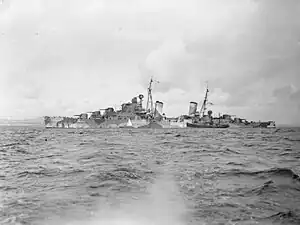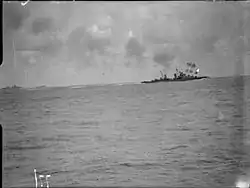 Naiad at anchor in the Firth of Forth, August 1940 | |
| History | |
|---|---|
| Name | Naiad |
| Namesake | Naiad |
| Builder | Hawthorn Leslie and Company Hebburn-on-Tyne |
| Laid down | 26 August 1937 |
| Launched | 3 February 1939 |
| Commissioned | 24 July 1940 |
| Identification | Pennant number: 93 |
| Fate | Sunk by U-565, 11 March 1942 |
| General characteristics (as built) | |
| Class and type | Dido-class light cruiser |
| Displacement |
|
| Length |
|
| Beam | 50.5 ft (15.4 m) |
| Draught | 14 ft (4.3 m) |
| Installed power |
|
| Propulsion | 4 shafts; 4 geared steam turbines |
| Speed | 32.25 knots (59.73 km/h; 37.11 mph) |
| Range | 6,824 km (3,685 nmi) at 16 knots (30 km/h; 18 mph) |
| Armament |
|
| Armor | |
HMS Naiad was a Dido-class light cruiser of the Royal Navy which served in the Second World War. She was sunk in action on 11 March 1942 south of Crete in the Mediterranean Sea.
History
She was built by Hawthorn Leslie and Company (Hebburn-on-Tyne, UK), her keel being laid down on 26 August 1937. She was launched on 3 February 1939, and commissioned 24 July 1940.
She initially joined the Home Fleet and was used for ocean trade protection duties. As part of the 15th Cruiser Squadron she took part in operations against German raiders following the sinking of the armed merchant cruiser Jervis Bay in November 1940. During that month she was involved in the destruction of the German weather ship Hinrich Freese off Jan Mayen. In December and January she escorted convoys to Freetown in Sierra Leone, but at the end of January 1941 was back in northern waters where she briefly sighted the German battleships Scharnhorst and Gneisenau south of Iceland as they were about to break out into the Atlantic (Operation Berlin). By May 1941 Naiad was with Force H in the Mediterranean on Malta convoy operations, and flagship of the 15th Cruiser Squadron. Naiad participated in the Crete operations, where she was badly damaged by German aircraft. She subsequently operated against Vichy French forces in Syria, where, together with the cruiser Leander, she engaged the French destroyer Guépard. For the remainder of her service, she was in the Mediterranean, mostly connected with the continual attempts to resupply Malta.

In March 1942 she sailed from Alexandria to attack an Italian cruiser that had been reported damaged. This report was false, and on the return, on 11 March 1942, Naiad was sunk by the German submarine U-565 south of Crete. 77 of her ship's company were lost.
References
- Campbell, N.J.M. (1980). "Great Britain". In Chesneau, Roger (ed.). Conway's All the World's Fighting Ships 1922–1946. New York: Mayflower Books. pp. 2–85. ISBN 0-8317-0303-2.
- Colledge, J. J.; Warlow, Ben (2006) [1969]. Ships of the Royal Navy: The Complete Record of all Fighting Ships of the Royal Navy (Rev. ed.). London: Chatham Publishing. ISBN 978-1-86176-281-8.
- Friedman, Norman (2010). British Cruisers: Two World Wars and After. Barnsley, UK: Seaforth Publishing. ISBN 978-1-59114-078-8.
- Raven, Alan & Roberts, John (1980). British Cruisers of World War Two. Annapolis, Maryland: Naval Institute Press. ISBN 0-87021-922-7.
- Rohwer, Jürgen (2005). Chronology of the War at Sea 1939–1945: The Naval History of World War Two (Third Revised ed.). Annapolis, Maryland: Naval Institute Press. ISBN 1-59114-119-2.
- Whitley, M. J. (1995). Cruisers of World War Two: An International Encyclopedia. London: Cassell. ISBN 1-86019-874-0.